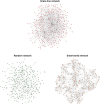Modeling the Life Cycle of the Intramitochondrial Bacterium " Candidatus Midichloria mitochondrii" Using Electron Microscopy Data
- PMID: 34154402
- PMCID: PMC8262999
- DOI: 10.1128/mBio.00574-21
Modeling the Life Cycle of the Intramitochondrial Bacterium " Candidatus Midichloria mitochondrii" Using Electron Microscopy Data
Abstract
"Candidatus Midichloria mitochondrii" is a Gram-negative bacterium that lives in strict intracellular symbiosis with the hard tick Ixodes ricinus, forming one of the most intriguing endosymbiosis described to date. The bacterium is capable of durably colonizing the host mitochondria, a peculiar tropism that makes "Ca. Midichloria mitochondrii" a very interesting tool to study the physiology of these cellular organelles. The interaction between the symbiont and the organelle has, however, been difficult to characterize. A parallelism with the predatory bacterium Bdellovibrio bacteriovorus has been drawn, suggesting the hypothesis that "Ca. Midichloria mitochondrii" could prey on mitochondria and consume them to multiply. We studied the life cycle of the bacterium within the host oocytes using a multidisciplinary approach, including electron microscopy, molecular biology, statistics, and systems biology. Our results were not coherent with a predatory-like behavior by "Ca. Midichloria mitochondrii" leading us to propose a novel hypothesis for its life cycle. Based on our results, we here present a novel model called the "mitochondrion-to-mitochondrion hypothesis." Under this model, the bacterium would be able to move from mitochondrion to mitochondrion, possibly within a mitochondrial network. We show that this model presents a good fit with quantitative electron microscopy data. IMPORTANCE Our results suggest that "Candidatus Midichloria mitochondrii," the intramitochondrial bacterium, does not invade mitochondria like predatory bacteria do but instead moves from mitochondrion to mitochondrion within the oocytes of Ixodes ricinus. A better understanding of the lifestyle of "Ca. Midichloria mitochondrii" will allow us to better define the role of this bacterial symbiont in the host physiology.
Keywords: Bdellovibrio-like hypothesis; Ixodes ricinus; endosymbiosis; mitochondrial network; “Candidatus Midichloria mitochondrii.
Figures




References
-
- Duron O, Binetruy F, Noël V, Cremaschi J, McCoy KD, Arnathau C, Plantard O, Goolsby J, Pérez de León AA, Heylen DJA, Van Oosten AR, Gottlieb Y, Baneth G, Guglielmone AA, Estrada-Peña A, Opara MN, Zenner L, Vavre F, Chevillon C. 2017. Evolutionary changes in symbiont community structure in ticks. Mol Ecol 26:2905–2921. doi:10.1111/mec.14094. - DOI - PubMed
-
- European Centre for Disease Prevention and Control, European Food Safety Authority. 2018. Tick maps. https://ecdc.europa.eu/en/disease-vectors/surveillance-and-disease-data/....
-
- Lo N, Beninati T, Sassera D, Bouman EAP, Santagati S, Gern L, Sambri V, Masuzawa T, Gray JS, Jaenson TGT, Bouattour A, Kenny MJ, Guner ES, Kharitonenkov IG, Bitam I, Bandi C. 2006. Widespread distribution and high prevalence of an alpha-proteobacterial symbiont in the tick Ixodes ricinus. Environ Microbiol 8:1280–1287. doi:10.1111/j.1462-2920.2006.01024.x. - DOI - PubMed

